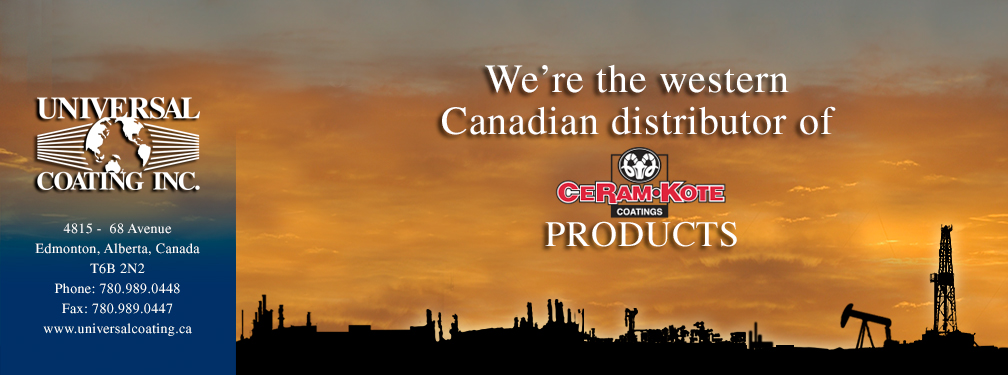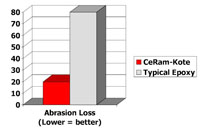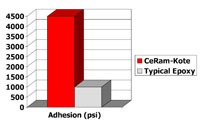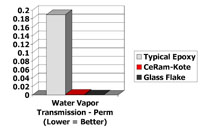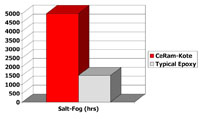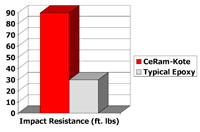5.0 Coating Application
For best results, spray-apply CeRam-Kote thin-film, Ceramic Epoxy coatings. Use pressure feed equipment such as high-volume, low-pressure (HVLP) equipment or Binks 2001 conventional spray equipment. Use Tungsten Carbide needles and fluid nozzles for maximum life and to prevent damage to the spray equipment. The compressed air source should be outfitted with air dryers as needed to supply moisture-free air. The air source must be dry. Moisture inhibits the catalytic reaction and produces an unsatisfactory finish that performs poorly.
| Type | HVLP | Conventional |
| Needle | 54-3950 Carbide | 563 CVT Carbide |
| Fluid Nozzle | 94VT (0.052") 1.33mm Carbide Tip | 63CVT Carbide |
| Air Nozzle | 97P | 63PB |
Airless equipment may also be used to apply CeRam-Kote Ceramic Epoxy Coatings to large areas. The carbide tip should be reversible and have an orifice size of 0.019-0.021inches.
CeRam-Kote Ceramic Epoxy Coatings may also be brush or roll applied. To brush, use a very fine bristled brush with natural bristles. To roll, use a high quality roller with a 1Ú4 inch (6.35 mm) or shorter nap.
Stripe Coating: All welds, joints, edges, and angle bars must be stripe coated with a light pass of two (2) to three (3) mils either by brush or spray application. Structures that cannot be reached by spraying must be stripe coated as well. It is recommended that contrasting colors of CeRam-Kote be utilized during this process to ensure proper coverage. Apply a first pass of four and one-half (41Ú2) to six (6) mils to the entire substrate (including the areas previously striped) and allow it to sit until tacky. Normally, thirty (30) to forty (40) minutes is sufficient, but allow more time if the temperature is below 70¡¡F (21.1¡¡C) or if more time is simply needed. Refer to FreecomÕs CSDS 1 for detailed instructions on cure time. Apply a second pass of four and one-half (41Ú2) to six (6) mils to the entire substrate for a total dry film thickness (DFT) of seven (7) to ten (10) mils. Apply additional mils, if recommended by factory, without incurring runs or sags.
Whenever possible, always apply the second coat in a cross-coat method to the first coat.
The finished application of the material appears glossy when wet. At room temperature 72¡F (22.2¡C) CeRam-Kote Ceramic Epoxy Coatings gel in approximately three (3) hours, a seventy percent (70%) cure is achieved within twelve (12) hours. A full cure is achieved in 2 to 7 days, depending on curing temperature.
Should a more rapid cure be desired, CeRam-Kote thin-film, Ceramic Epoxy Coatings can cure in one (1) hour if the temperature is elevated to 150¡F (65.6¡C), however, some flexibility is lost by rapid-curing
Unless in a controlled environment, coating will only be permitted during daylight hours when air and substrate temperature is above 40¡F (4.4¡C). No coating will be permitted when substrate is wet from rain or dew, when surfaces are less than 5¡F (3¡C) above the dew point, or when the relative humidity is greater than 85%. Moisture will inhibit the curing agent reaction in the coating system and the coating will not cure or perform properly.
To achieve highest gloss possible, and to deter amine blush issues with CeRam-Kote 54¨ and CeRam-Kote 99: Once substrate has been coated, wait at least 5 minutes, but not longer than 30 minutes. Apply 120¡F to 130¡F (49¡C to 54¡C) heat to coated item. Allow substrate of item to reach 120¡F to 130¡F (49¡C to 54¡C). Once this occurs, remove heat.

